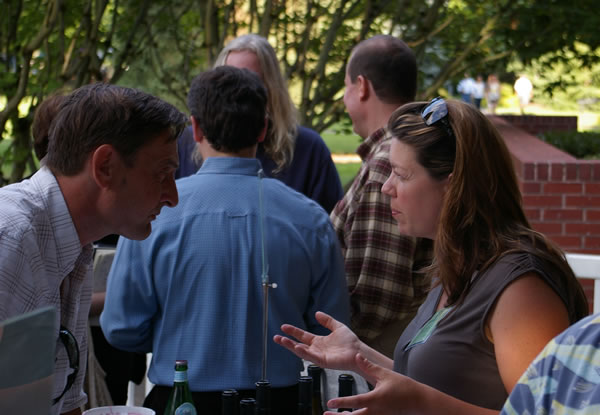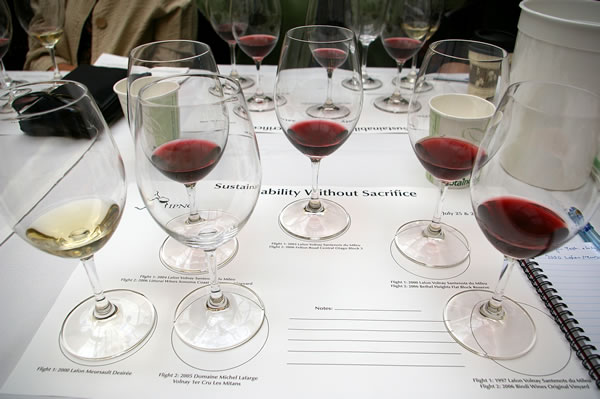|
Dominique
Lafon: a seminar on sustainable wine growing from
one of Burgundy's stars
A seminar on 'Sustainability without sacrifice'
at the IPNC, McMinnville, Oregon, July 2008, with Dominique Lafon,
chaired by Jasper Morris.

Dominic Lafon (left) chats with
Luisa Ponzi
As part of the 2008 International Pinot Noir
Celebration, celebrated Burgundy winemaker Dominique Lafon was the
keynote speaker at a seminar on 'Sustainability without sacrifice'.
He told the story about under his stewardship this great domaine
shifted from conventional viticulture towards organics and then
biodynamics. We also got to taste some of his wines.
Lafon is a family-owned property, and Dominique the
fourth generation to have stewardship of it. His great grandfather
married a woman from Meursault who had some vineyards. 'In those
days you didn't make money with vineyards', says Dominique. 'He was
a wealthy collector who wanted wine to drink with his friends.'
14 different wines are made from 14 hectares,
one-third of which is Pinot Noir, mostly in Volnay. The majority of
his vines are Chardonnay in Meursault, with a little bit of
Montrachet.
When Dominique's father arrived at the domaine in
1956 it was a hard time for Burgundy. he was an engineer who did
share cropping. The way this worked is that people worked in the
vineyards and were allowed to keep half of the crop for themselves
in exchange for their labour, with the domaine receiving the other
half. It wasn't until the early 1980s that the contract was stopped
and the Lafon family took back control of all their vineyards.
Dominique arrived in 1987, after studying oenology,
including spells in Oregon and California. Back in the
1980s farming practices varied. There were nine different people
taking care of the vineyards (including Pierre Morey), and all had
different methods of cultivation. Weedkillers and chemical
fertilizers were being used.
Dominique reveals how at this time a group of
growers, all of his generation, felt that there should be a change.
Together they moved in the direction of cleaner agriculture. 'I
started with the chemicals when I took over', he reveals. 'there
were all these merchants selling us products. they worked, but then
they tell you they have a stronger product'. He was concerned that
he might be poisoning his family. 'The more you try to fight nature,
the more resistance emerges, and you need to fight more and more. It
has no end'.
In 1989, Dominique became interested in organic
cultivation. 'It took three years to change', he recalls. ‘I
realized I should change in 1989, and by 1992 we were organic. I
then visited some growers who had started using biodynamic
techniques and their vineyards looked better.’ Dominique
experimented with it in 1995 on 1 hectare, and then moved to
applying it on three hectares. ‘The vineyards looked healthier’,
he recalls. ‘It worked well.’
But can biodynamics be applied on a large scale?
‘We decided to go for the whole estate. For me, biodynamics is
just applying a few products: horn manure, horn silica and some
plant extracts (such as nettles and horsetail).’ Dominique reckons
that for 14 hectares, applying biodynamics involved 100 hours more
work per year. ‘It takes you to what is happening in your
environment around the vines: you understand what is going on around
your vines. The sun, the moon, the stars; there are planetary
influences.’
He also thinks that the vineyards look different.
‘When I started the experiment, visually it was impressive. The
vineyard had miserable crops, but it grew better and we got more
crops.’ Dominique reports that there is a transition period, and
that the most difficult part is changing from chemical agriculture
to organic agriculture. ‘The vineyards cultivated with fertilizers
are like those Tour de France guys’, he jokes. ‘It is quite a
hard transition. When you start ploughing the vineyards you cut out
the superficial roots. You have to get the soils started again to
feed the vines. BD500 [one of the preparations] helps a lot in
getting deeper roots.’ He points out that it’s actually easier
if you don’t go from conventional viticulture to organics and then
to biodynamics, but go straight from conventional to biodynamics.
Is there anything in the cellar that is done
differently now that Dominique has changed to biodynamics? ‘Not
that much’, he replies. With Pinot Noir he doesn’t need to
extract as much. ‘Pushy extraction was in fashion in the 1990s,
but Pinot Noir has to be elegant and I don’t want too much
extraction’.
Burgundy expert Jasper Morris MW, who has 25
years’ experience with Lafon wines, has seen a change in how the
wines taste since the switch to biodynamics. He cites three main
differences. ‘First, there is enhanced purity. Second, there is
greater minerality. Third, precise vineyard definition is clearer
and more focused.’ ‘Each wine becomes more typical of each
vineyard’, agrees Dominique. ‘It is very satisfying’.

Lafon Meursault Desirée 2000
Broad, slightly nutty nose with some rich, toasty complexity.
The palate is quite dense and savoury with lots of impact and good
acidity. 92/100
Lafon Volnay Santenots de Mileu 2004
Pure, vivid and fresh. The palate is a bit earthy with crisp,
spicy, fresh red fruits. There’s some structure and a hint of
greenness. A stylish, crisp red with good acidity. 90/100
Lafon Volnay Santenots de
Mileu 2003
Ripe berry fruits here with some grippy tannins. Quite fresh,
still, but with ripeness to the fruit. Good balance between the rich
fruit and the tannins. 89/100
Lafon
Volnay Santenots de Mileu 2000
Perfumed herb and cherry fruit nose with a supple, subtly green
character. The palate has some earthiness with elegant smooth cherry
fruit character. Evolving nicely with good acidity. A very fresh,
focused style. This was a rain affected vintage and they had to rush
to pick. It’s a gentle wine, peaking now. 91/100
Lafon Volnay Santenots de Mileu 1997
Complex, evolved, earthy, spicy nose. The palate has nice
density and lovely complexity, with earth, herbs, cherries and
spice. Real elegance and depth: a rich wine with a future. 93/100
Wines tasted 07/08
Find
these wines with wine-searcher.com
See also:
Back
to top
|

